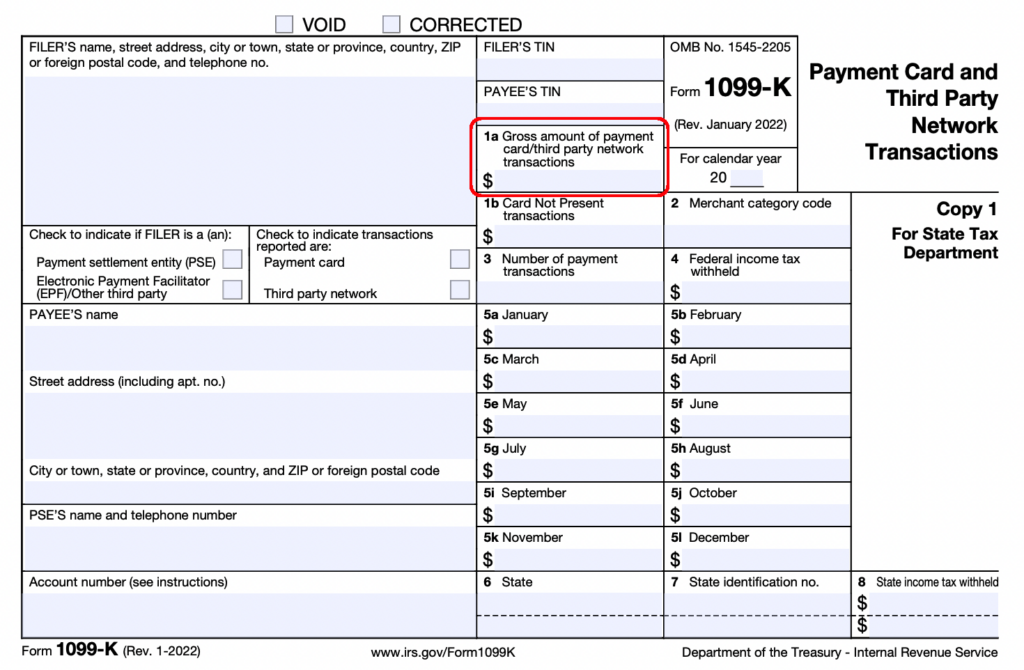1099-Ks are inconsistent – but that’s ok
Back when we first launched, we wrote a blog post about 1099-Ks and where sellers can expect to find the amounts that make up the total in Box 1a (Gross amount of payment card/third-party network transactions.) At the time, we were referencing eBay’s calculations.
But, as we approach the end of the tax year, we’ve learned that different platforms calculate their Box 1a amounts differently, often around whether or not sales tax collected is included.

Below is a sample of our findings – if you discover more and want to pass them along, we’re happy to update the list.
Sales tax NOT included in Box 1a
For example, the following platforms indicate in their documentation that sales tax is likely NOT included in the gross amount reported to the IRS:
Ebay
In their help page, eBay states: “Additionally, Form 1099-K does not include the sales tax when it is automatically collected and remitted by eBay.”
Poshmark
This support page from Poshmark states: “Your Form 1099-K will only include income as calculated by gross sales (including fees, refunds, and cancelled orders) on the Poshmark platform.”
Etsy
Their help page is a bit less clear, stating that the gross sales includes “Sales tax collected by you.” However, just below that, they make this statement: “In some cases, Etsy collects sales tax from buyers and remits it to tax authorities on behalf of sellers. If Etsy has collected tax on your behalf, these amounts won’t appear on your 1099-K form.”
Sales tax included in Box1a
However, other platforms either don’t spell it out very clearly or imply the opposite – that sales tax collected IS included in the Box 1a amount:
Amazon
There does not appear to be an easy-to-find, definitive answer, but this thread on their discussion board indicates that sales is included.
Mercari
This page from their help center states that their Unadjusted Gross Payment combines various amounts, including: “Sales tax charged to buyer (a separately stated sales tax paid by the Buyer at the time of purchase and remitted directly to the state under Mercari’s sales tax registration)”
Square, Shopify and likely most shopping cart platforms
A quick search finds this discussion from the Shopify community stating that their 1099K had sales tax included. And another from Square users bringing up the exact same point
Disclaimer
The content in this page should not be construed as legal or tax advice. Please consult an attorney or tax professional regarding your specific tax situation.
Creating confusion
The IRS’s own instructions for Schedule C provides a great starting point for confusion. Looking at the instructions for Line 23 (expenses for taxes and licenses,) you will find the following two statements:
You can deduct the following taxes and licenses on this line.
- State and local sales taxes imposed on you as the seller of goods or services. If you collected this tax from the buyer, you must also include the amount collected in gross receipts or sales on line 1.
and
Do not deduct the following.
- State and local sales taxes imposed on the buyer that you were required to collect and pay over to state or local governments. These taxes are not included in gross receipts or sales nor are they a deductible expense. However, if the state or local government allowed you to retain any part of the sales tax you collected, you must include that amount as income on line 6.
Clear as mud, right?
Adding to the confusion, there are statements from some “experts” that it’s critical to have your tax return line up with the forms that the IRS receives. But if you are a multi-channel seller, and the IRS receives multiple 1099-Ks that are based on different calculations, how are you supposed to get your amounts to line up?
It is unlikely that members of Congress understood the full potential for inconsistency when they introduced Form 1099-K for the 2011 tax year. Yet it has remained relatively unchanged for the last 12 years. And now, with the threshold for “gross amount” dropping to $600, this confusion will impact more small sellers than ever.
It doesn’t have to be a big deal
From our perspective, what’s most important is that you get to the correct amount of tax owed. That’s where good bookkeeping comes into play. If you are a multi-channel seller facing the possibility of receiving multiple 1099-Ks that included different numbers (like sales tax,) it becomes critical to have the order-level details (product price, any discounts, shipping, sales tax collected, fees charged, etc) broken out and properly categorized so that you can sub-total by any or all of them. This way, should anyone come asking, you can produce accurate reports of every total, and even drill down to the specific transactions behind them.
With Seller Ledger, we automatically import order-level details from the top online sales channels, along with banks and credit cards, to help you produce a Schedule C tax report that is accurate for your business. Anyone can try Seller Ledger free for 30-days, no credit card required.
